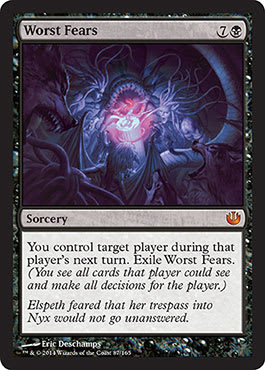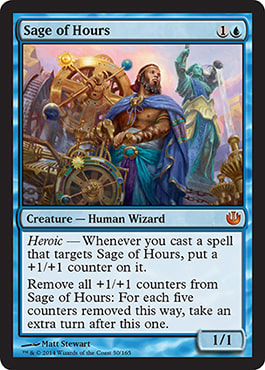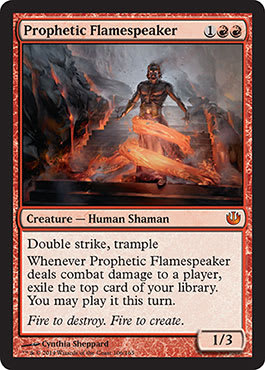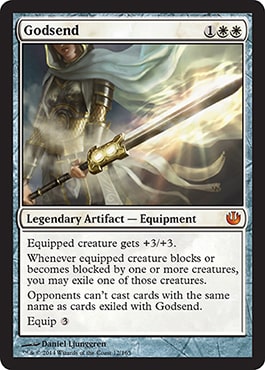Journey into Nyx turned 10 years old just a few weeks ago! It's honestly hard to believe that it's been that long. The third set of the Theros block was considered to be somewhat underpowered yet a notable step up from the previous Born of the Gods with some interesting designs. The set's Strive mechanic changed the texture of Limited by altering it from a go tall strategy to a go wide strategy and introduced the beloved Constellation mechanic as well!
It also happened to have one of the coolest bonuses ever in Magic: the chance at opening a booster containing all 15 of the block's gods. I even got to open one in some prize packs once upon a time!

Five of those gods just happened to make up half of the mythics in this set, and there's some real solid options this time around. As usual, we're going to rank them all! Let's dive right into them!
Number Ten
When Mindslaver first came out, it was a jaw dropping card that caught the attention and imagination of players everywhere. One of the reasons for this was how novel and original it was (a whole new set of rules needed to be crafted for it) but the other reason were the ways in which you could recur and reuse it. It would be difficult to do this with Worst Fears, even if it didn't exile, but the fact that it does exile itself makes it far less useful. There was a brief moment later on when it found some minor utility in a Commander deck that spiked its price, but soon after it went to being as undesirable as it was when it first released.
Number Nine
For a long time, Sage of Hours was firmly in the bulk mythic camp. These days, it's still very close to this point, however it's gained some usefulness in Commander thanks to the number of ways to put +1/+1 on different creatures. For example, think of something like the release of Ozolith, the Shattered Spire. Despite this, it remains a tall ask to get five or more counters on it in a meaningful way and is difficult to utilize the heroic ability in a lot of Blue-based lists. It saw no Constructed play and in its time it simply wasn't that good in Commander.
Number Eight
Prophetic Flamespeaker was a tremendously hyped card when it first came out. The idea that you could attack, deal damage, and get two instances of impulse draw seemed really powerful. After the set came out, it went on a slow but steady decline down to being a bulk mythic within a few months' time. It only saw very minor play in Standard, basically no play anywhere else in Constructed, and had a respectable showing in Cube after the fact. A really cool card that ended up feeling like an unfortunate disappointment.
Number Seven
Time has been somewhat kind to Kruphix with how much Commander has blossomed to become the main way people play Magic today. However, at the time of Journey into Nyx's release, the card wasn't that big of a player in the format and - perhaps more importantly - saw exactly zero play anywhere else. I certainly would not call it one of the worst cards in the set, but compared to the other cards in the set, its utility is rather meager.
Number Six
Ajani came out and was by and large a meme for his simple and arguably low impact ultimate. Despite that, this iteration of everyone's favorite albino leonin also had some solid play for his ability to find creatures and dishing out power buffs to those creatures. Because of this, he saw some fairly modest Standard play and wasn't a bad Commander option either, even if his ultimate was pretty much unusable.
Number Five
Godsend is an excellent test in card evaluation. Up until this point, exile effects were rather sparse and usually involved temporary exiling a la Oblivion Ring or Banisher Priest. When players saw an equipment that could just exile creatures over and over again while also granting a power buff, it blew their minds. Not only that but it buffs your creature and then stops your opponents from getting to cast new versions of their creatures? Unreal! In practice, the card mostly just made your creatures unblockable until they got picked off by removal, but Godsend truly wowed people when it first came out and remains a popular casual card to this day.
Number Four
Pharika is one of the gods in this set that was less of a Commander staple and instead saw a decent amount of play in Standard. Her utility in Commander is real rough since you're only exiling things, meaning there aren't a ton of ways to build around her. In Constructed formats, though, this is way more useful. Not only does it stop various graveyard shenanigans, but it can also very generally just eat creatures you kill so that you can in turn fill up your own board.
Number Three
Iroas had a ton of hype backing him for the possibilities he present to aggro players. You could swing in, make it difficult for your opponents to block, and also make your creatures harder to pick off. At four mana, it seemed like a real tough sell in competitive Constructed since it was harder to turn on as a creature even though it hits hard. Despite this, it was highly coveted by many players and became an instant Cube and Commander staple for any aggressive deck.
Number Two
It's funny Keranos no longer sees much play. He's been outshined in Cube and is unplayable in Commander due to being rather low impact in a multiplayer setting. He also no longer sees any play in any Constructed format, but when he was first released he was an absolute house. His utility in Standard was fairly modest, largely showing up in various Jeskai lists. In Modern, however, he showed up all over the place for a while in a myriad of decks as a truly potent finishing play. Couple this with the fact that in this era, Keranos was a top pick in many Cubes and you had the makings of a massively popular and highly in demand card, even if his utility has gone down with time.
Number One
Athreos is a testament to how middle of the road Journey into Nyx was. The card reads like something that would be maybe fourth or fifth place on your average list of mythic rankings. Here, though, it's far and away the best card. That's not to say the set was a dismal failure because it frankly wasn't, but it was a certain degree of underwhelming and Athreos had a lot of power driving it. Players were jazzed to be able to keep getting their creatures back or heavily tax life totals in ways that play far better than most punisher mechanic cards often do. It's also a great early example of a card with little Standard or Modern play that was highly treasured in Commander and Cubes for how powerful and cheap this recursion was.
Paige Smith
Twitter: @TheMaverickGal
Twitch: twitch.tv/themaverickgirl
YouTube: TheMaverickGal



































